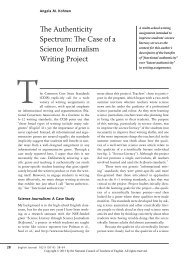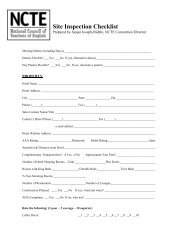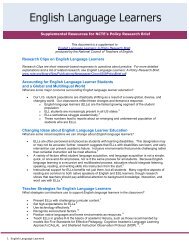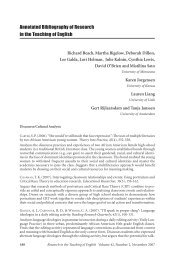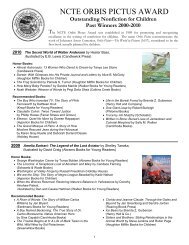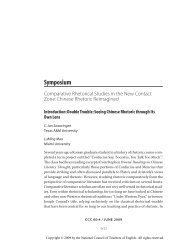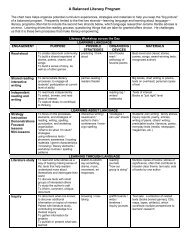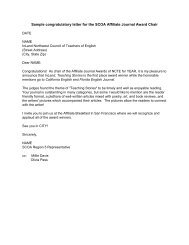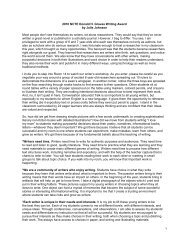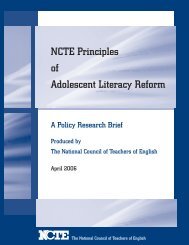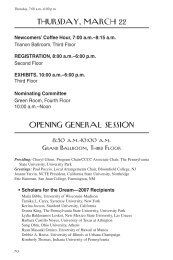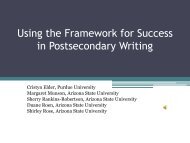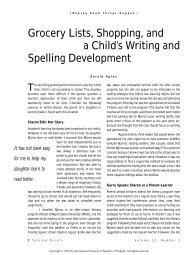Annotated Bibliography of Research in the Teaching of English
Annotated Bibliography of Research in the Teaching of English
Annotated Bibliography of Research in the Teaching of English
- No tags were found...
Create successful ePaper yourself
Turn your PDF publications into a flip-book with our unique Google optimized e-Paper software.
<strong>Annotated</strong> <strong>Bibliography</strong> 209ily view bil<strong>in</strong>gualism as a resource. The researchers used <strong>the</strong>se f<strong>in</strong>d<strong>in</strong>gs to create <strong>in</strong>terventionsthat would serve <strong>the</strong> goal <strong>of</strong> develop<strong>in</strong>g more critically m<strong>in</strong>ded bil<strong>in</strong>gual teachers.HEFFERNAN, L., & LEWISON, M. (2005). What’s lunch got to do with it? Critical literacy and <strong>the</strong>discourse <strong>of</strong> <strong>the</strong> lunchroom. Language Arts, 83(2), 107-117.Analyzes <strong>in</strong>terviews with children <strong>in</strong> a 3rd grade classroom that had been engaged <strong>in</strong> criticalliteracy practices. The <strong>in</strong>terviews centered on a social action project that <strong>the</strong> children took upon <strong>the</strong>ir own that <strong>in</strong>volved desegregat<strong>in</strong>g gender divisions at lunch tables. Discourse analytictools based on Gee’s (1999) methods were used to identify <strong>the</strong> students’ cultural models, situatedmean<strong>in</strong>gs, and social identities. The authors advocate a sociological approach to criticalliteracy that helps students to grapple with <strong>the</strong> <strong>in</strong>tersection <strong>of</strong> social structures, texts, and <strong>the</strong>irlived realities.JUZWIK, M. M. (2006). Perform<strong>in</strong>g curriculum: Build<strong>in</strong>g ethos through narratives <strong>in</strong> pedagogicaldiscourse. Teachers College Record, 108(4), 489-528.Analyzes <strong>the</strong> discourse <strong>of</strong> one teacher to determ<strong>in</strong>e how she used narratives dur<strong>in</strong>g a Holocaustunit to build an ethos <strong>of</strong> authority as a teacher. Rhetorical features <strong>of</strong> <strong>the</strong> narratives were exam<strong>in</strong>ed<strong>in</strong> relation to each narrative subgenre. The majority <strong>of</strong> narratives were event and experiencenarratives that conveyed basic <strong>in</strong>formation. Hypo<strong>the</strong>tical and dramatic narratives provideda bridge between imag<strong>in</strong>ation and historical fact. Implications po<strong>in</strong>t to <strong>the</strong> importantfunction <strong>of</strong> narrative to shape knowledge and artfully construct teacher authority.LONGAKER, M. G. (2005). Market rhetoric and <strong>the</strong> Ebonics debate. Written Communication, 22(4),472-501.Us<strong>in</strong>g <strong>the</strong> example <strong>of</strong> <strong>the</strong> Ebonics debate, <strong>the</strong> author shows how pedagogical discourses areshaped by <strong>the</strong> political economy and <strong>the</strong> rhetoric <strong>of</strong> fast capital. Implications po<strong>in</strong>t to newpedagogies that streng<strong>the</strong>n connections between rhetorical analysis and writ<strong>in</strong>g by <strong>in</strong>corporat<strong>in</strong>ganalysis <strong>of</strong> how we talk about <strong>the</strong> teach<strong>in</strong>g <strong>of</strong> writ<strong>in</strong>g.MILNER, R. H. (2005). Develop<strong>in</strong>g multicultural curriculum <strong>in</strong> a predom<strong>in</strong>antly White teach<strong>in</strong>gcontext: Lessons from an African American teacher <strong>in</strong> a suburban <strong>English</strong> classroom. CurriculumInquiry, 35(4), 391-427.With<strong>in</strong> <strong>the</strong> framework <strong>of</strong> Banks’ (1998) model <strong>of</strong> multicultural curriculum transformation, <strong>the</strong>author studied an African American <strong>English</strong> teacher’s work <strong>in</strong> a predom<strong>in</strong>antly White school.The teacher provided her students with a critical transformational approach to <strong>English</strong> studiesvalued by her students, but discourses and belief systems with<strong>in</strong> <strong>the</strong> school created obstaclesand lack <strong>of</strong> support for her work. The author concludes that teachers’ cultural and racial identitiesshape <strong>the</strong>ir curricular decisions and that critical multicultural education is important <strong>in</strong>all contexts.MOITA-LOPES, L. P. (2006). Queer<strong>in</strong>g literacy teach<strong>in</strong>g: Analyz<strong>in</strong>g gay-<strong>the</strong>med discourses <strong>in</strong> afifth-grade class <strong>in</strong> Brazil. Journal <strong>of</strong> Language, Identity, and Education, 5(1), 31-50.Analyzes children’s uses <strong>of</strong> gay-<strong>the</strong>med discourses <strong>in</strong> teacher-led class discussions and <strong>in</strong> non<strong>in</strong>structionalpeer talk <strong>in</strong> a 5th grade class. F<strong>in</strong>ds that students’ peer talk openly <strong>in</strong>cluded gay<strong>the</strong>mes,whereas <strong>in</strong>structional talk precluded such <strong>the</strong>mes. Argues for pedagogic conversationsthat situate sexualities as discursively constructed and presents an example <strong>of</strong> how this mightwork <strong>in</strong> practice.ROGERS, R., MALANCHARUVIL-BERKES, E., & MOSLEY, M. (2005). Discourse analysis <strong>in</strong> education: Areview <strong>of</strong> <strong>the</strong> literature. Review <strong>of</strong> Educational <strong>Research</strong>, 75(3), 365-416.Reviews scholarship on critical discourse analysis across five social science databases with <strong>the</strong>purpose <strong>of</strong> understand<strong>in</strong>g how educators use CDA and how its use by educators shapes CDA



